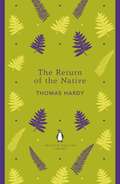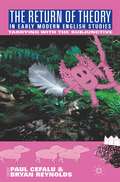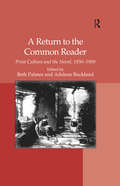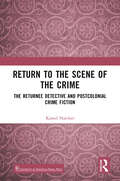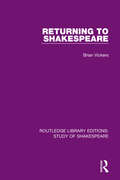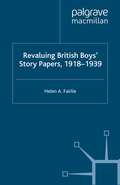- Table View
- List View
The Return of Proserpina: Cultural Poetics of Sicily from Cicero to Dante
by Sarah SpenceSicily and the strategies of empire in the poetic imagination of classical and medieval EuropeIn the first century BC, Cicero praised Sicily as Rome’s first overseas province and confirmed it as the mythic location for the abduction of Proserpina, known to the Greeks as Persephone, by the god of the underworld. The Return of Proserpina takes readers from Roman antiquity to the late Middle Ages to explore how the Mediterranean island offered authors a setting for forces resistant to empire and a location for displaying and reclaiming what has been destroyed.Using the myth of Proserpina as a through line, Sarah Spence charts the relationship Western empire held with its myths and its own past. She takes an in-depth, panoramic look at a diverse range of texts set on Sicily, demonstrating how the myth of Proserpina enables a discussion of empire in terms of balance, loss, and negotiation. Providing new readings of authors as separated in time and culture as Vergil, Claudian, and Dante, Spence shows how the shape of Proserpina’s tale and perceptions of the island change from a myth of loss to one of redemption, with the volcanic Mt. Etna playing an increasingly central role.Delving into the ways that myth and geography affect politics and poetics, The Return of Proserpina explores the power of language and the written word during a period of tremendous cultural turbulence.
The Return of Proserpina: Cultural Poetics of Sicily from Cicero to Dante
by Sarah SpenceSicily and the strategies of empire in the poetic imagination of classical and medieval EuropeIn the first century BC, Cicero praised Sicily as Rome’s first overseas province and confirmed it as the mythic location for the abduction of Proserpina, known to the Greeks as Persephone, by the god of the underworld. The Return of Proserpina takes readers from Roman antiquity to the late Middle Ages to explore how the Mediterranean island offered authors a setting for forces resistant to empire and a location for displaying and reclaiming what has been destroyed.Using the myth of Proserpina as a through line, Sarah Spence charts the relationship Western empire held with its myths and its own past. She takes an in-depth, panoramic look at a diverse range of texts set on Sicily, demonstrating how the myth of Proserpina enables a discussion of empire in terms of balance, loss, and negotiation. Providing new readings of authors as separated in time and culture as Vergil, Claudian, and Dante, Spence shows how the shape of Proserpina’s tale and perceptions of the island change from a myth of loss to one of redemption, with the volcanic Mt. Etna playing an increasingly central role.Delving into the ways that myth and geography affect politics and poetics, The Return of Proserpina explores the power of language and the written word during a period of tremendous cultural turbulence.
The Return of Resentment: The Rise and Decline and Rise Again of a Political Emotion (The Life of Ideas)
by Robert A. SchneiderCharts the long history of resentment, from its emergence to its establishment as the word of the moment. The term “resentment,” often casually paired with words like “hatred,” “rage,” and “fear,” has dominated US news analysis since November 2016. Despite its increased use, this word seems to defy easy categorization. Does “resentment” describe many interlocking sentiments, or is it just another way of saying “anger”? Does it suggest an irrational grievance, as opposed to a legitimate callout of injustice? Does it imply political leanings, or is it nonpartisan by nature? In The Return of Resentment, Robert A. Schneider explores these questions and more, moving from eighteenth-century Britain to the aftermath of the French Revolution to social movements throughout the twentieth century. Drawing on a wide range of writers, thinkers, and historical experiences, Schneider illustrates how resentment has morphed across time, coming to express a collective sentiment felt by people and movements across the political spectrum. In this history, we discover resentment’s modernity and its ambiguity—how it can be used to dismiss legitimate critique and explain away violence, but also convey a moral stance that demands recognition. Schneider anatomizes the many ways resentment has been used to label present-day movements, from followers of Trump and supporters of Brexit to radical Islamicists and proponents of identity politics. Addressing our contemporary political situation in a novel way, The Return of Resentment challenges us to think critically about the roles different emotions play in politics.
The Return of Resentment: The Rise and Decline and Rise Again of a Political Emotion (The Life of Ideas)
by Robert A. SchneiderCharts the long history of resentment, from its emergence to its establishment as the word of the moment. The term “resentment,” often casually paired with words like “hatred,” “rage,” and “fear,” has dominated US news analysis since November 2016. Despite its increased use, this word seems to defy easy categorization. Does “resentment” describe many interlocking sentiments, or is it just another way of saying “anger”? Does it suggest an irrational grievance, as opposed to a legitimate callout of injustice? Does it imply political leanings, or is it nonpartisan by nature? In The Return of Resentment, Robert A. Schneider explores these questions and more, moving from eighteenth-century Britain to the aftermath of the French Revolution to social movements throughout the twentieth century. Drawing on a wide range of writers, thinkers, and historical experiences, Schneider illustrates how resentment has morphed across time, coming to express a collective sentiment felt by people and movements across the political spectrum. In this history, we discover resentment’s modernity and its ambiguity—how it can be used to dismiss legitimate critique and explain away violence, but also convey a moral stance that demands recognition. Schneider anatomizes the many ways resentment has been used to label present-day movements, from followers of Trump and supporters of Brexit to radical Islamicists and proponents of identity politics. Addressing our contemporary political situation in a novel way, The Return of Resentment challenges us to think critically about the roles different emotions play in politics.
The Return of Sherlock Holmes: Selected Stories (Oxford World's Classics)
by Arthur Conan DoyleArthur Conan Doyle famously killed off Sherlock Holmes in 1893, in the short story 'The Final Problem', but was tempted to bring him back to life ten years later, in the thirteen tales that comprise The Return of Sherlock Holmes. While the outcry that supposedly followed Holmes' death was mostly apocryphal (the claim that readers wore black armbands in mourning has been frequently cited but never actually proved), by 1893 there was a substantial readership for Holmes' two series of adventures published in the Strand Magazine and two earlier novels. Doyle returned to Holmes in 1901-2 with The Hound of the Baskervilles, a novel set before the events of 'The Final Problem'; the commercial success of the serialisation in the Strand led Doyle to consider reviving the Holmes stories on a longer-term basis. Accordingly, in 1903 Doyle was contracted by the American magazine Collier's Weekly to supply six more Holmes stories; the agreement was extended to six more, with a final extension for a thirteenth story ('The Second Stain') that Doyle (mistakenly) believed to be the closing episode of the Holmes adventures. These thirteen tales make up this volume.
The Return of Sherlock Holmes (Oxford World's Classics)
by Arthur Conan DoyleArthur Conan Doyle famously killed off Sherlock Holmes in 1893, in the short story 'The Final Problem', but was tempted to bring him back to life ten years later, in the thirteen tales that comprise The Return of Sherlock Holmes. While the outcry that supposedly followed Holmes' death was mostly apocryphal (the claim that readers wore black armbands in mourning has been frequently cited but never actually proved), by 1893 there was a substantial readership for Holmes' two series of adventures published in the Strand Magazine and two earlier novels. Doyle returned to Holmes in 1901-2 with The Hound of the Baskervilles, a novel set before the events of 'The Final Problem'; the commercial success of the serialisation in the Strand led Doyle to consider reviving the Holmes stories on a longer-term basis. Accordingly, in 1903 Doyle was contracted by the American magazine Collier's Weekly to supply six more Holmes stories; the agreement was extended to six more, with a final extension for a thirteenth story ('The Second Stain') that Doyle (mistakenly) believed to be the closing episode of the Holmes adventures. These thirteen tales make up this volume.
The Return of the Mughal: Historical Fiction and Despotism in Colonial India, 1863–1908
by Alex PadamseeThis Pivot explores the uses of the Mughal past in the historical fiction of colonial India. Through detailed reconsiderations of canonical works by Rudyard Kipling, Flora Annie Steel and Romesh Chunder Dutt, the author argues for a more complex and integral understanding of the part played by the Mughal imaginary in colonial and early Indian nationalist projections of sovereignty. Evoking the rich historical and transnational contexts of these literary narratives, the study demonstrates the ways in which, at successive moments of crisis and contestation in the later Raj, the British Indian state continued to be troubled by its early and profound investments in models of despotism first located by colonial administrators in the figure of the Mughal emperor. At the heart of these political fictions lay the issue of territoriality and the founding problem of a British claim to sole proprietorship of Indian land – a form of Orientalist exceptionalism that at once underpinned and could never fully be integrated with the colonial rule of law. Alongside its recovery of a wealth of popular and often overlooked colonial historiography, The Return of the Mughal emphasises the relevance of theories of political theology – from Carl Schmitt and Ernst Kantorowicz to Talal Asad and Giorgio Agamben – to our understanding of the fictional and jurisprudential histories of colonialism. This study aims to show just how closely the pageantry and romance of empire in India connects to its early politics of terror and even today continues to inform the figure of the Mughal in the sectarian politics of Hindu Nationalism.
The Return of the Native (The Penguin English Library)
by Thomas Hardy'Do I desire unreasonably much in wanting what is called life - music, poetry, passion, war, and all the beating and pulsing that is going on in the great arteries of the world?'Tempestuous Eustacia Vye passes her days dreaming of passionate love and the escape it may bring from the small community of Egdon Heath. Hearing that Clym Yeobright is to return from Paris, she sets her heart on marrying him, believing that through him she can leave rural life and find fulfilment elsewhere. But she is to be disappointed, for Clym has dreams of his own, and they have little in common with Eustacia's. Their unhappy marriage causes havoc in the lives of those close to them, in particular Damon Wildeve, Eustacia's former lover, Clym's mother and his cousin Thomasin. The Retun of the Native illustrates the tragic potential of romantic illusion and how its protagonists fail to recognize their opportunities to control their own destinies.The Penguin English Library - 100 editions of the best fiction in English, from the eighteenth century and the very first novels to the beginning of the First World War.
The Return of the Storyteller in Contemporary Fiction
by Areti DragasFocusing on the figure of the storyteller, this study breaks new ground in the approach to reading contemporary literature by identifying a growing interest in storytelling. For the last thirty years contemporary fiction has been influenced by theoretical discourses, textuality and writing. Only since the rise of postcolonialism have academic critics been more overtly interested in stories, where high theory frameworks are less applicable. However, as we move through various contemporary contexts engaging with postcolonial identities and hybridity, to narratives of disability and evolutionary accounts of group and individual survival, a common feature of all is the centrality of story, which posits both the idea of survival and the passing on of traditions.This book closely examines this preoccupation with story and storytelling through a close reading of sixteen contemporary international novels written in English which are about actual 'storytellers', revealing how death of the author has given birth to the storyteller.
The Return of the Storyteller in Contemporary Fiction (Continuum Literary Studies)
by Areti DragasFocusing on the figure of the storyteller, this study breaks new ground in the approach to reading contemporary literature by identifying a growing interest in storytelling. For the last thirty years contemporary fiction has been influenced by theoretical discourses, textuality and writing. Only since the rise of postcolonialism have academic critics been more overtly interested in stories, where high theory frameworks are less applicable. However, as we move through various contemporary contexts engaging with postcolonial identities and hybridity, to narratives of disability and evolutionary accounts of group and individual survival, a common feature of all is the centrality of story, which posits both the idea of survival and the passing on of traditions. This book closely examines this preoccupation with story and storytelling through a close reading of sixteen contemporary international novels written in English which are about actual 'storytellers', revealing how death of the author has given birth to the storyteller.
The Return of Theory in Early Modern English Studies: Tarrying with the Subjunctive
by E. Aston B. Reynolds Paul CefaluThis collection looks at the growing rapprochement between contemporary theory and early modern English literary-cultural studies. With sections on posthumanism and cognitive science, political theology, and rematerialism and performance, the essays incorporate recent theoretical inquiries into new readings of early modern texts.
The Return of Theory in Early Modern English Studies, Volume II
by Paul Cefalu Gary Kuchar Bryan ReynoldsThis companion volume to The Return of Theory in Early Modern English Studies: Tarrying with the Subjunctive exemplifies the new directions in which the field is going as well as the value of crossing disciplinary boundaries within and beyond the humanities. Topics studied include posthumanism, ecological studies, and historical phenomenology.
The Return of Ulysses: A Cultural History of Homer's Odyssey
by Edith HallWhether they focus on the bewitching song of the Sirens, his cunning escape from the cave of the terrifying one-eyed Cyclops, or the vengeful slaying of the suitors of his beautiful wife Penelope, the stirring adventures of Ulysses/Odysseus are amongst the most durable in human culture. The picaresque return of the wandering pirate-king is one of the most popular texts of all time, crossing East-West divides and inspiring poets and film-makers worldwide. But why, over three thousand years, has the Odyssey's appeal proved so remarkably resilient and long-lasting? In her much-praised book Edith Hall explains the enduring fascination of Homer's epic in terms of its extraordinary susceptibility to adaptation. Not only has the story reflected a myriad of different agendas, but - from the tragedies of classical Athens to modern detective fiction, film, travelogue and opera - it has seemed perhaps uniquely fertile in generating new artistic forms. Cultural texts as diverse as Joyce's Ulysses, Suzanne Vega's Calypso, Monteverdi's Il Ritorno d'Ulisse in Patria, the Coen Brothers' O Brother Where Art Thou?, Daniel Vigne's Le Retour de Martin Guerre and Anthony Minghella's Cold Mountain all show that Odysseus is truly a versatile hero. His travels across the wine-dark Aegean are journeys not just into the mind of one of the most brilliantly creative of all the ancient Greek writers. They are as much a voyage beyond the boundaries of a narrative which can plausibly lay claim to being the quintessential global phenomenon.
A Return to the Common Reader: Print Culture and the Novel, 1850–1900
by Adelene BucklandIn 1957, Richard Altick's groundbreaking work The English Common Reader transformed the study of book history. Putting readers at the centre of literary culture, Altick anticipated-and helped produce-fifty years of scholarly inquiry into the ways and means by which the Victorians read. Now, A Return to the Common Reader asks what Altick's concept of the 'common reader' actually means in the wake of a half-century of research. Digging deep into unusual and eclectic archives and hitherto-overlooked sources, its authors give new understanding to the masses of newly literate readers who picked up books in the Victorian period. They find readers in prisons, in the barracks, and around the world, and they remind us of the power of those forgotten readers to find forbidden texts, shape new markets, and drive the production of new reading material across a century. Inspired and informed by Altick's seminal work, A Return to the Common Reader is a cutting-edge collection which dramatically reconfigures our understanding of the ordinary Victorian readers whose efforts and choices changed our literary culture forever.
A Return to the Common Reader: Print Culture and the Novel, 1850–1900
by Adelene BucklandIn 1957, Richard Altick's groundbreaking work The English Common Reader transformed the study of book history. Putting readers at the centre of literary culture, Altick anticipated-and helped produce-fifty years of scholarly inquiry into the ways and means by which the Victorians read. Now, A Return to the Common Reader asks what Altick's concept of the 'common reader' actually means in the wake of a half-century of research. Digging deep into unusual and eclectic archives and hitherto-overlooked sources, its authors give new understanding to the masses of newly literate readers who picked up books in the Victorian period. They find readers in prisons, in the barracks, and around the world, and they remind us of the power of those forgotten readers to find forbidden texts, shape new markets, and drive the production of new reading material across a century. Inspired and informed by Altick's seminal work, A Return to the Common Reader is a cutting-edge collection which dramatically reconfigures our understanding of the ordinary Victorian readers whose efforts and choices changed our literary culture forever.
Return to the Scene of the Crime: The Returnee Detective and Postcolonial Crime Fiction
by Kamil NaickerA crime novel, at once disturbing and perversely comforting, factually has been known to curtail social anxieties through the ‘open and shut case’ of its narrative form. But what happens to that form in a world where guilt and innocence are not easily assigned? Return to the Scene of the Crime takes place on the trope of an investigator returning to the post-colony on a quest for knowledge. In tandem with solving the case, they must also grapple with the complexities of their origins. Kamil Naicker shows how five authors defy generic expectations to illustrate the complexities of personal identity, transitional justice, and civil violence in the post-colonial world. Congregating novels set in South Africa, China, Guatemala, Sri Lanka and Somalia, this book intervenes in literary studies by bringing the trend of the returnee figure and exploring the possibilities of world-making through the explosion of a familiar form. Print edition not for sale in Sub Saharan Africa.
Return to the Scene of the Crime: The Returnee Detective and Postcolonial Crime Fiction
by Kamil NaickerA crime novel, at once disturbing and perversely comforting, factually has been known to curtail social anxieties through the ‘open and shut case’ of its narrative form. But what happens to that form in a world where guilt and innocence are not easily assigned? Return to the Scene of the Crime takes place on the trope of an investigator returning to the post-colony on a quest for knowledge. In tandem with solving the case, they must also grapple with the complexities of their origins. Kamil Naicker shows how five authors defy generic expectations to illustrate the complexities of personal identity, transitional justice, and civil violence in the post-colonial world. Congregating novels set in South Africa, China, Guatemala, Sri Lanka and Somalia, this book intervenes in literary studies by bringing the trend of the returnee figure and exploring the possibilities of world-making through the explosion of a familiar form. Print edition not for sale in Sub Saharan Africa.
Returning the Gift: Modernism and the Thought of Exchange
by Rebecca ColesworthyFrom debates about reparations to the rise of the welfare state, the decades following World War I saw a widespread turn across disciplines to questions about the nature and role of gifts: What is a gift? What do gifts mean and do? Which individuals and institutions have the authority to give? Marshalling wide-ranging interdisciplinary research, Returning the Gift argues that these questions centrally shaped literary modernism. The book begins by revisiting the locus classicus of twentieth-century gift theory — the French sociologist Marcel Mauss's 1925 essay, The Gift: The Form and Reason for Exchange in Archaic Societies. His title notwithstanding, the gift Mauss envisions is not primitive or pre-capitalist, but rather a distinctively modern phenomenon. Subsequent chapters offer sustained, nuanced readings of novels and nonfiction by Virginia Woolf, Jean Rhys, Gertrude Stein, and H.D. from the 1920s to 1940s, underscoring the ways their writing is illuminated by contemporaneous developments in the social sciences, economics, and politics, while also making a case for their unique contributions to broader debates about gifts. Not only do these writers insist that literature is a special kind of gift, but they also pose challenges to the gift's feminization in the work of both their Victorian forebears and contemporary male theorists. Each of these writers uses tropes and narratives of giving — of hospitality, sympathy, reciprocity, charity, genius, and kinship — to imagine more egalitarian social possibilities under the conditions of the capitalist present. The language of the gift is not, as we might expect, a mark of hostility to the market so much as a means of giving form to the 'society' in market society — of representing everyday experiences of exchange that the myth of the free market works, even now, to render unthinkable.
Returning the Gift: Modernism and the Thought of Exchange
by Rebecca ColesworthyFrom debates about reparations to the rise of the welfare state, the decades following World War I saw a widespread turn across disciplines to questions about the nature and role of gifts: What is a gift? What do gifts mean and do? Which individuals and institutions have the authority to give? Marshalling wide-ranging interdisciplinary research, Returning the Gift argues that these questions centrally shaped literary modernism. The book begins by revisiting the locus classicus of twentieth-century gift theory — the French sociologist Marcel Mauss's 1925 essay, The Gift: The Form and Reason for Exchange in Archaic Societies. His title notwithstanding, the gift Mauss envisions is not primitive or pre-capitalist, but rather a distinctively modern phenomenon. Subsequent chapters offer sustained, nuanced readings of novels and nonfiction by Virginia Woolf, Jean Rhys, Gertrude Stein, and H.D. from the 1920s to 1940s, underscoring the ways their writing is illuminated by contemporaneous developments in the social sciences, economics, and politics, while also making a case for their unique contributions to broader debates about gifts. Not only do these writers insist that literature is a special kind of gift, but they also pose challenges to the gift's feminization in the work of both their Victorian forebears and contemporary male theorists. Each of these writers uses tropes and narratives of giving — of hospitality, sympathy, reciprocity, charity, genius, and kinship — to imagine more egalitarian social possibilities under the conditions of the capitalist present. The language of the gift is not, as we might expect, a mark of hostility to the market so much as a means of giving form to the 'society' in market society — of representing everyday experiences of exchange that the myth of the free market works, even now, to render unthinkable.
Returning to John Donne
by Achsah GuibboryCollected in this volume are Achsah Guibbory’s most important and frequently cited essays on Donne, which, taken together, present her distinctive and evolving vision of the poet. The book includes an original, substantive introduction as well as new essays on the Devotions upon Emergent Occasions, the Songs and Sonnets, and the subject of Donne and toleration. Over the course of her career, Guibbory has asked different questions about Donne but has always been concerned with recovering multiple historical and cultural contexts and locating Donne’s writing in relation to them. In the essays here, she reads Donne within various contexts: the early modern thinking about time and history; religious attitudes towards sexuality; the politics of early modern England; religious conflicts within the church. While her approach has always been historicist, she has also foregrounded Donne’s distinctiveness, showing how (and why) he continues to speak powerfully to us now. Presented together here, with reflections on the trajectory of her engagement with Donne, Achsah Guibbory illuminates Donne’s understanding that erotic, spiritual, and political issues are often intertwined, and reveals how this understanding resonates in our own times.
Returning to John Donne
by Achsah GuibboryCollected in this volume are Achsah Guibbory’s most important and frequently cited essays on Donne, which, taken together, present her distinctive and evolving vision of the poet. The book includes an original, substantive introduction as well as new essays on the Devotions upon Emergent Occasions, the Songs and Sonnets, and the subject of Donne and toleration. Over the course of her career, Guibbory has asked different questions about Donne but has always been concerned with recovering multiple historical and cultural contexts and locating Donne’s writing in relation to them. In the essays here, she reads Donne within various contexts: the early modern thinking about time and history; religious attitudes towards sexuality; the politics of early modern England; religious conflicts within the church. While her approach has always been historicist, she has also foregrounded Donne’s distinctiveness, showing how (and why) he continues to speak powerfully to us now. Presented together here, with reflections on the trajectory of her engagement with Donne, Achsah Guibbory illuminates Donne’s understanding that erotic, spiritual, and political issues are often intertwined, and reveals how this understanding resonates in our own times.
Returning to Shakespeare (Routledge Library Editions: Study of Shakespeare)
by Brian VickersReturning to Shakespeare addresses two broad areas of Shakespeare criticism: the unity of form and meaning, and the history of the plays’ reception. Originally published in 1989, the collection represents the best of Brian Vickers’ work from the previous fifteen years, in a revised and expanded form. The first part of the book focuses on the connection between a work’s structural or formal properties and our experience of it. A new study of the Sonnets shows how personal relationships are literally embodied in personal pronouns. An essay on Shakespeare’s hypocrites (Richard III, Iago, Macbeth) analyses the uncomfortable intimacy established between them and the audience by means of soliloquies and asides. Another traces the interplay between politics and the family in Coriolanus, two forms of pressure which combine to push the hero outside society. In the second part Professor Vickers examines some key episodes in the history of Shakespeare criticism. One essay reviews the persistence of drastically altered adaptations of Shakespeare on the London stage from the 1690s to the 1830s, due to the conservatism of both theatre managers and audience. Another reconstructs the debate over Hamlet’s character in the last quarter of the eighteenth century, in which the Romantic image of a hero lacking control of his faculties emerged for the first time. This is an important collection by an outstanding Shakespeare critic which will interest specialists and general readers alike.
Returning to Shakespeare (Routledge Library Editions: Study of Shakespeare)
by Brian VickersReturning to Shakespeare addresses two broad areas of Shakespeare criticism: the unity of form and meaning, and the history of the plays’ reception. Originally published in 1989, the collection represents the best of Brian Vickers’ work from the previous fifteen years, in a revised and expanded form. The first part of the book focuses on the connection between a work’s structural or formal properties and our experience of it. A new study of the Sonnets shows how personal relationships are literally embodied in personal pronouns. An essay on Shakespeare’s hypocrites (Richard III, Iago, Macbeth) analyses the uncomfortable intimacy established between them and the audience by means of soliloquies and asides. Another traces the interplay between politics and the family in Coriolanus, two forms of pressure which combine to push the hero outside society. In the second part Professor Vickers examines some key episodes in the history of Shakespeare criticism. One essay reviews the persistence of drastically altered adaptations of Shakespeare on the London stage from the 1690s to the 1830s, due to the conservatism of both theatre managers and audience. Another reconstructs the debate over Hamlet’s character in the last quarter of the eighteenth century, in which the Romantic image of a hero lacking control of his faculties emerged for the first time. This is an important collection by an outstanding Shakespeare critic which will interest specialists and general readers alike.
Revaluing British Boys' Story Papers, 1918-1939 (Critical Approaches to Children's Literature)
by H. A FairlieThis book explores the phenomenon of the story paper, the meanings and values children took from their reading, and the responses of adults to their reading choices. It argues for the revaluing of the story paper in the inter-war years, giving the genre a pivotal role in the development of children's literature.
Revealing Media Bias in News Articles: NLP Techniques for Automated Frame Analysis
by Felix HamborgThis open access book presents an interdisciplinary approach to reveal biases in English news articles reporting on a given political event. The approach named person-oriented framing analysis identifies the coverage’s different perspectives on the event by assessing how articles portray the persons involved in the event. In contrast to prior automated approaches, the identified frames are more meaningful and substantially present in person-oriented news coverage. The book is structured in seven chapters: Chapter 1 presents a few of the severe problems caused by slanted news coverage and identifies the research gap that motivated the research described in this thesis. Chapter 2 discusses manual analysis concepts and exemplary studies from the social sciences and automated approaches, mostly from computer science and computational linguistics, to analyze and reveal media bias. This way, it identifies the strengths and weaknesses of current approaches for identifying and revealing media bias. Chapter 3 discusses the solution design space to address the identified research gap and introduces person-oriented framing analysis (PFA), a new approach to identify substantial frames and to reveal slanted news coverage. Chapters 4 and 5 detail target concept analysis and frame identification, the first and second component of PFA. Chapter 5 also introduces the first large-scale dataset and a novel model for target-dependent sentiment classification (TSC) in the news domain. Eventually, Chapter 6 introduces Newsalyze, a prototype system to reveal biases to non-expert news consumers by using the PFA approach. In the end, Chapter 7 summarizes the thesis and discusses the strengths and weaknesses of the thesis to derive ideas for future research on media bias. This book mainly targets researchers and graduate students from computer science, computational linguistics, political science, and further social sciences who want to get an overview of the relevant state of the art in the other related disciplines and understand and tackle the issue of bias from a more effective, interdisciplinary viewpoint.




